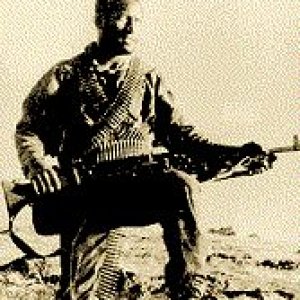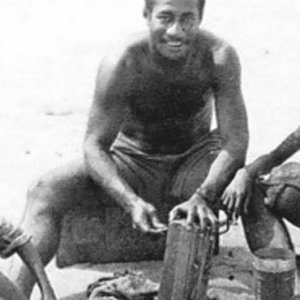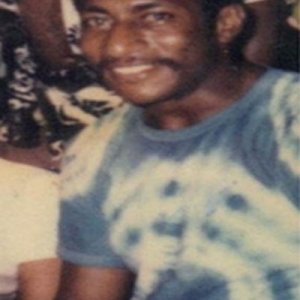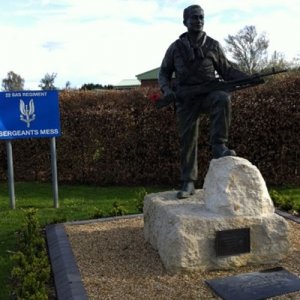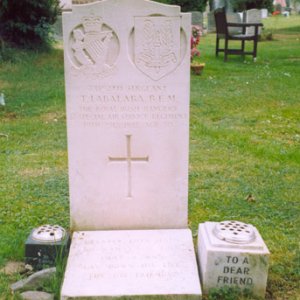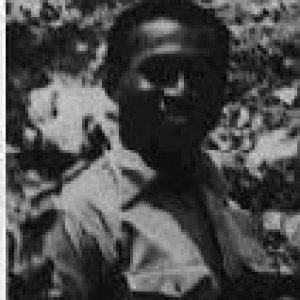- SURNAME
Labalaba
- FORENAME
Talaiasi
- UNIT
B Squadron
- RANK
Corporal
- NUMBER
23892771
- DATE OF DEATH
19th July 1972
- AGE
30
- GRAVESITE
Hereford (St Martin's) Churchyard, Herefordshire Section D Row XI Grave 24
- ADDITIONAL INFORMATION
parent unit Royal Irish Rangers (Sergeant)
born 13.7.1942
from Nawaka, Fiji
son of Torika Canau Laudola, Nawaka, Fiji (mother)
22 SAS (served Aden)
returned to RIR (award B.E.M.)
22 SAS again (served Oman)
award Mention in Despatches
KIA Mirbat, Dhofar, Oman
London Gazette 44600, 31st May 1968, Page 6323 (BEM)
DATE OF DEATH:
19-Jul-1972AWARD:
https://www.specialforcesroh.com/index.php?threads/labalaba-talaiyasi.30936/CITATION:
British Empire Medal : Lcpl Labalaba was one of the first of a very all and highly selected group of Fijian soldiers to join the Special Air Service. Lcpl Labalaba has been on almost continuous operations in both Borneo and the Middle East. Throughout this period whatever the task or conditions, his standards of operational efficiency in action have been exemplary and his conduct outstanding.
His personal courage and determination have come to the fore on a number of occasions. The most noted are firstly in Borneo where Labalaba played a leading part in a most successful SAS ambush personally killing or wounding a number of Indonesians by his calmness and accurate fire.
Secondly during recent months in Aden Lcpl Labalaba was employed, either alone or in a very small group, on a particular long term hazardous esoteric operation. During this period he mingled with the locals and was constantly under the threat of exposure and attack. In one instance when he was commanding a small covert patrol and on being attacked he successfully, with his group, killed three and wounded two terrorists.
Lcpl Labalaba's conduct and exceptional high personal standards of leadership and courage since joining the Special Air Service in 1965 have not only been an example to his Fijian countryman and land of his birth, but an inspiration to his fellow British comrades within the Special Air Service Regiment.
Place : Borneo/s, Arabia
Date of Action : September 1965 - October 1967
How Employed : Trooper and Troop Corporal
Mention in Despatches : MIRBAT is a medium sized and important fishing town lying some 25 miles East of Salalah. It is wired in and has a small military garrison of local gendarmerie and ASKARS, the latter being equivalent to home guard. The defence of the town is the responsibility of the SAS contingent and full responsibility for its control lies with the SAS Commander.
There has been no major attack on the town of MIRBAT since operations commenced in DHOFAR some two years ago until the night of the 19th July. On this night the communist insurgents decided to mount, against MIRBAT, the largest most determined and best planned attack that they have launched in the whole campaign. From captured enemy personnel it has since become clear that they were confident of their success and that had they captured the town they intended to occupy it permanently and establish a seat of communist government in DHOFAR. The political implications of such a dramatic turn of events need no further expansion.
At 0530 hours on the morning of the 19th July, mortars started to rain in on the MIRBAT Garrison. The Garrison was stood to and under Captain KEALY's direction commenced the battle for the town. For over 4 hours the communists pressed home their attack; they infiltrated the town; they destroyed the stone defences with RCL, Rocket Launcher and Mortar fire; they concentrated a major effort against the SAS personnel in the town; they closed to grenade range and fought with a ferocity, tenacity and blind dedication that is the mark of all Communist shook troops. They launched this attack with an estimated 250 men against a small garrison town whose defence was designed to repel attacks from no more than a dozen men acting without determination. It was only after 4 hours of continual and ferocious fighting that they finally admitted defeat and withdrew leaving behind some 40 wounded and killed. A subsequent radio intercept indicates that they suffered at least 86 casualties and subsequent intelligence reports indicate that this figure may be as high as 100 or more.
At 0530 hours in the morning of the 19th July the enemy commenced their attack on MIBAT with an opening barrage of mortar and RCL fire. LABALABA, together with another Fijian soldier, had the responsibility for manning the 25 pdr. It should be pointed out that neither of these soldiers had had any previous artillery training other than a 2 day course on the mechanics of handling this particular gun. Under heavy and accurate mortar fire they covered the 500 yards from the main SAS position to the Dhofar gendarmerie fort where the 25 pdr was sited. Quickly and effectively they brought it into action.
It soon became clear that the enemy considered the 25 pdr to be a key objective in the initial stages of the attack and they demonstrated this by concentrating an effective and accurate fire on the crew with all their available weapons. Subsequent debriefing of captured enemy personnel confirmed this impression and made it clear that the enemy intended to capture the gun, man it with their own trained crews and turn it on the town. They had not bargained with LABALABA and TAKAVESI.
After some time LABALABA became wounded in the face. This made little difference to his determination to continue firing the 25 pdr and at the same time to repel the determined hand to hand attacks by small groups of enemy. Between the two of them, and later reinforced by two others, these two Fijians denied the 25 pdr position to the enemy for several hours despite the fact that they were both ultimately wounded. LABALABA personally conducted and directed the fire of the 25 pdr over open sites and at point blank range. He continued to control and fire the gun when TAKAVESI was unable to assist in the heavy work of handling the ammunition due to the severity of his wounds. Finally his luck ran out and he was killed instantly by a bullet through the head.
There can be no doubt that the leadership and determination displayed by LABALABA was an inspiration to every man in the garrison; equally it provided a bulward which the enemy found impossible to breach. Had the enemy taken the 25 pdr. there is no doubt that they would have captured the city by directing it onto all the substantial defensive positions. To a large extent LABALABA's leadership, his incredible bravery and his determination in the face of over whelming odds have contributed disproportionately to the defeat of the enemy and to the retention of the city of MIRBAT in Government hands.
Place : Mirbat, Dhofar, Sultanate of Oman
Date of Action : 19th July 1972
How Employed : Member of BATT, Mirbat
His personal courage and determination have come to the fore on a number of occasions. The most noted are firstly in Borneo where Labalaba played a leading part in a most successful SAS ambush personally killing or wounding a number of Indonesians by his calmness and accurate fire.
Secondly during recent months in Aden Lcpl Labalaba was employed, either alone or in a very small group, on a particular long term hazardous esoteric operation. During this period he mingled with the locals and was constantly under the threat of exposure and attack. In one instance when he was commanding a small covert patrol and on being attacked he successfully, with his group, killed three and wounded two terrorists.
Lcpl Labalaba's conduct and exceptional high personal standards of leadership and courage since joining the Special Air Service in 1965 have not only been an example to his Fijian countryman and land of his birth, but an inspiration to his fellow British comrades within the Special Air Service Regiment.
Place : Borneo/s, Arabia
Date of Action : September 1965 - October 1967
How Employed : Trooper and Troop Corporal
Mention in Despatches : MIRBAT is a medium sized and important fishing town lying some 25 miles East of Salalah. It is wired in and has a small military garrison of local gendarmerie and ASKARS, the latter being equivalent to home guard. The defence of the town is the responsibility of the SAS contingent and full responsibility for its control lies with the SAS Commander.
There has been no major attack on the town of MIRBAT since operations commenced in DHOFAR some two years ago until the night of the 19th July. On this night the communist insurgents decided to mount, against MIRBAT, the largest most determined and best planned attack that they have launched in the whole campaign. From captured enemy personnel it has since become clear that they were confident of their success and that had they captured the town they intended to occupy it permanently and establish a seat of communist government in DHOFAR. The political implications of such a dramatic turn of events need no further expansion.
At 0530 hours on the morning of the 19th July, mortars started to rain in on the MIRBAT Garrison. The Garrison was stood to and under Captain KEALY's direction commenced the battle for the town. For over 4 hours the communists pressed home their attack; they infiltrated the town; they destroyed the stone defences with RCL, Rocket Launcher and Mortar fire; they concentrated a major effort against the SAS personnel in the town; they closed to grenade range and fought with a ferocity, tenacity and blind dedication that is the mark of all Communist shook troops. They launched this attack with an estimated 250 men against a small garrison town whose defence was designed to repel attacks from no more than a dozen men acting without determination. It was only after 4 hours of continual and ferocious fighting that they finally admitted defeat and withdrew leaving behind some 40 wounded and killed. A subsequent radio intercept indicates that they suffered at least 86 casualties and subsequent intelligence reports indicate that this figure may be as high as 100 or more.
At 0530 hours in the morning of the 19th July the enemy commenced their attack on MIBAT with an opening barrage of mortar and RCL fire. LABALABA, together with another Fijian soldier, had the responsibility for manning the 25 pdr. It should be pointed out that neither of these soldiers had had any previous artillery training other than a 2 day course on the mechanics of handling this particular gun. Under heavy and accurate mortar fire they covered the 500 yards from the main SAS position to the Dhofar gendarmerie fort where the 25 pdr was sited. Quickly and effectively they brought it into action.
It soon became clear that the enemy considered the 25 pdr to be a key objective in the initial stages of the attack and they demonstrated this by concentrating an effective and accurate fire on the crew with all their available weapons. Subsequent debriefing of captured enemy personnel confirmed this impression and made it clear that the enemy intended to capture the gun, man it with their own trained crews and turn it on the town. They had not bargained with LABALABA and TAKAVESI.
After some time LABALABA became wounded in the face. This made little difference to his determination to continue firing the 25 pdr and at the same time to repel the determined hand to hand attacks by small groups of enemy. Between the two of them, and later reinforced by two others, these two Fijians denied the 25 pdr position to the enemy for several hours despite the fact that they were both ultimately wounded. LABALABA personally conducted and directed the fire of the 25 pdr over open sites and at point blank range. He continued to control and fire the gun when TAKAVESI was unable to assist in the heavy work of handling the ammunition due to the severity of his wounds. Finally his luck ran out and he was killed instantly by a bullet through the head.
There can be no doubt that the leadership and determination displayed by LABALABA was an inspiration to every man in the garrison; equally it provided a bulward which the enemy found impossible to breach. Had the enemy taken the 25 pdr. there is no doubt that they would have captured the city by directing it onto all the substantial defensive positions. To a large extent LABALABA's leadership, his incredible bravery and his determination in the face of over whelming odds have contributed disproportionately to the defeat of the enemy and to the retention of the city of MIRBAT in Government hands.
Place : Mirbat, Dhofar, Sultanate of Oman
Date of Action : 19th July 1972
How Employed : Member of BATT, Mirbat
WEB LINKS:
https://www.thegazette.co.uk/London/issue/44600/supplement/6323 (BEM)https://discovery.nationalarchives.gov.uk/details/r/D7631416 (MiD)
https://discovery.nationalarchives.gov.uk/details/r/D7488106 (MiD)
https://discovery.nationalarchives.gov.uk/details/r/D7631570 (BEM)
FINDAGRAVE:
https://www.findagrave.com/memorial/79750144/talaiasi-labalaba
Last edited by a moderator:


